2001 BMW 330i TOURING ESP
[x] Cancel search: ESPPage 145 of 203

145n
IndexDataTechnologyRepairsCar careControlsOverview
Caring for your vehicleCare of upholstery materials Depressions in the upholstery that
result from everyday use can be
brushed smooth by brushing against
the nap with a lightly dampened brush.
The tendency of the pile to lie in a
particular direction on velour upholstery
is not a quality defect, and, just as on
home textiles or clothing, cannot be
avoided.
Lint on upholstery materials, textile or
leather remnants that have been worn
into the upholstery may be removed
with a lint brush or a Velcro
â brush. A
cleaning glove is available for especially
"stubborn" lint. Stains and fairly large
areas of dirt should be cleaned off with-
out delay, using lukewarm water and an
interior cleaner, stain remover or appro-
priate cleaning fluid. Brush the fabric
afterwards to restore its appearance.
If the vehicle is to be stored for an ex-
tended period, or if it is exposed to in-
tense sunlight, cover all the seats or the
windows to prevent fading.
Use the cleaning and car-care
products available at your BMW
center.<
The buildup of an electrostatic charge
on the seat covers, particularly if
atmospheric humidity is low, can give
the occupants an unpleasant electric
shock if they touch metal body parts
after leaving the vehicle. Although this is
not dangerous in any way, it can be
avoided by touching a bare or polished
metal part of the vehicle while getting
out.
Leather care The leather
* upholstery used by BMW
is a natural product of the highest
quality, processed using state-of-the-
art methods to ensure that it will main-
tain its high quality for years to come,
provided that it is properly cared for.
Because this product is manufactured
using natural materials, you must make
allowance for its special characteristics
and for the peculiarities of its use
and care.
Regular periodic cleaning and care
are essential, as dust and road dirt act
as abrasives in the pores and creases
of the material. This leads to wear
spots and premature brittleness on
the surface of the leather. We there-
fore suggest that you clean the leather
with a vacuum cleaner or cloth at
frequent intervals.
For cleaning, use BMW leather
cleaning foam.
Since dirt and grease gradually attack
the protective layer of the leather, the
cleaned surfaces should be treated
with BMW leather care agent. This also
acts as an antistatic agent.
For protection against dampness
or moisture, treat the leather with an
impregnating agent made by BMW.
Page 147 of 203
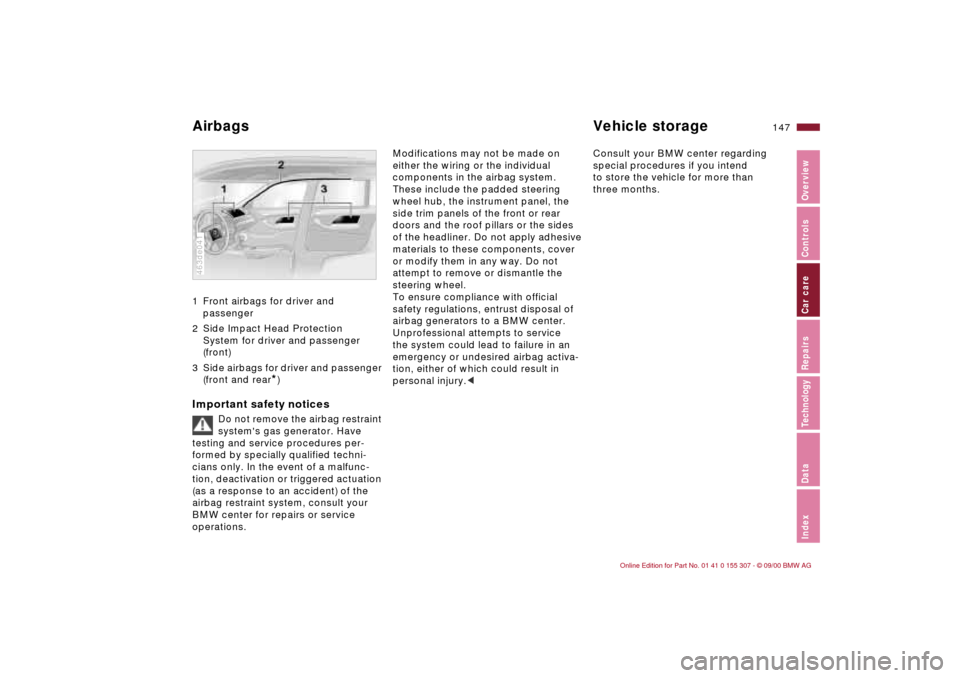
147n
IndexDataTechnologyRepairsCar careControlsOverview
Airbags Vehicle storage1 Front airbags for driver and
passenger
2 Side Impact Head Protection
System for driver and passenger
(front)
3 Side airbags for driver and passenger
(front and rear
*)
Important safety notices
Do not remove the airbag restraint
system's gas generator. Have
testing and service procedures per-
formed by specially qualified techni-
cians only. In the event of a malfunc-
tion, deactivation or triggered actuation
(as a response to an accident) of the
airbag restraint system, consult your
BMW center for repairs or service
operations.
463de041
Modifications may not be made on
either the wiring or the individual
components in the airbag system.
These include the padded steering
wheel hub, the instrument panel, the
side trim panels of the front or rear
doors and the roof pillars or the sides
of the headliner. Do not apply adhesive
materials to these components, cover
or modify them in any way. Do not
attempt to remove or dismantle the
steering wheel.
To ensure compliance with official
safety regulations, entrust disposal of
airbag generators to a BMW center.
Unprofessional attempts to service
the system could lead to failure in an
emergency or undesired airbag activa-
tion, either of which could result in
personal injury.
to store the vehicle for more than
three months.
Page 149 of 203

149n
IndexDataTechnologyRepairsCar careControlsOverview
OBD interface socket The interface socket for onboard diag-
nostics is located on the driver's side at
the left-hand bottom of the dashboard
and under a cover. The cover has the
letters "OBD" on it.
The purpose of the OBD system is to
ensure proper emission control system
operation for the vehicle's lifetime by
monitoring emission-related compo-
nents and systems for deterioration
and malfunction.460us250
An illuminated indicator informs
you of the need for service, not
that you need to stop the
vehicle. Your system should be
checked, however, at the earliest possi-
ble opportunity.
If the indicator blinks or flashes, this
indicates a high level of engine misfire.
Reduce speed and contact your near-
est BMW center immediately. Severe
engine misfire over even a short period
of time can seriously damage emission
control components, especially the
catalytic converter.
Service Engine Soon warning
lamp for Canadian models.
If the fuel filler cap is not properly
tightened, the OBD system can
detect leaking vapor and the indicator
will light up. If the fuel filler cap is then
tightened, the indicator will usually go
out after a short period of time.<
Page 156 of 203
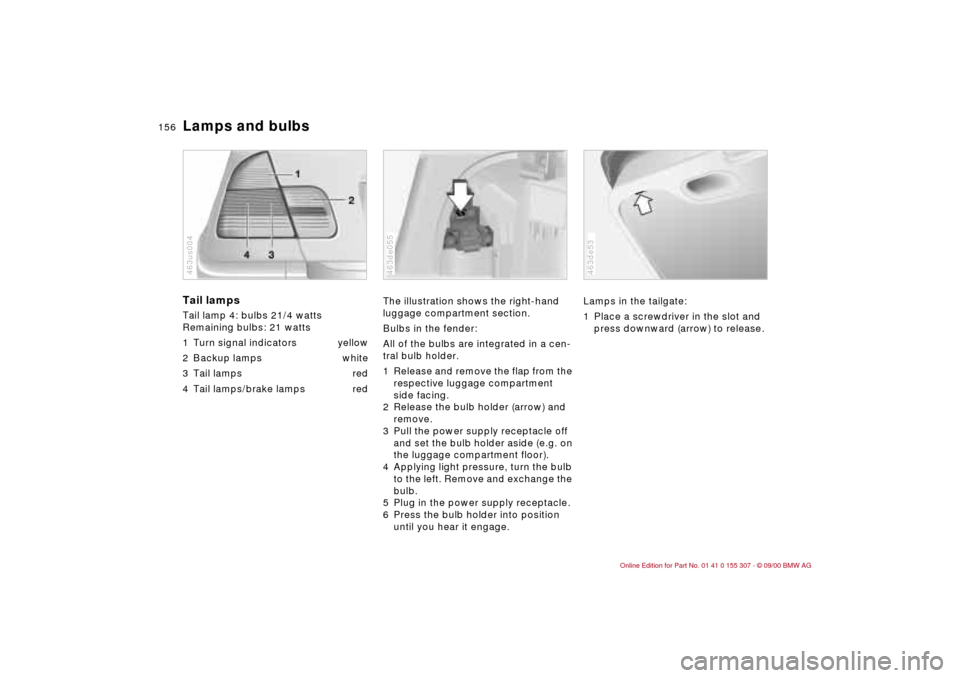
156n
Lamps and bulbsTail lamps Tail lamp 4: bulbs 21/4 watts
Remaining bulbs: 21 watts
1 Turn signal indicators yellow
2 Backup lamps white
3 Tail lamps red
4 Tail lamps/brake lamps red463us004
The illustration shows the right-hand
luggage compartment section.
Bulbs in the fender:
All of the bulbs are integrated in a cen-
tral bulb holder.
1 Release and remove the flap from the
respective luggage compartment
side facing.
2 Release the bulb holder (arrow) and
remove.
3 Pull the power supply receptacle off
and set the bulb holder aside (e.g. on
the luggage compartment floor).
4 Applying light pressure, turn the bulb
to the left. Remove and exchange the
bulb.
5 Plug in the power supply receptacle.
6 Press the bulb holder into position
until you hear it engage.463de055
Lamps in the tailgate:
1 Place a screwdriver in the slot and
press downward (arrow) to release.463de53
Page 164 of 203
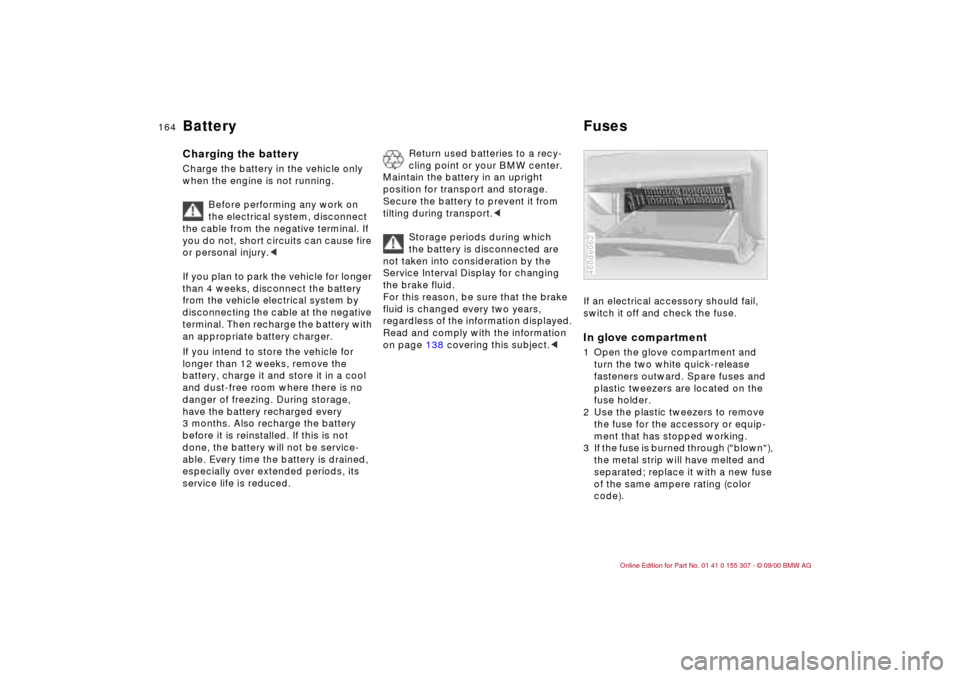
164n
Battery FusesCharging the battery Charge the battery in the vehicle only
when the engine is not running.
Before performing any work on
the electrical system, disconnect
the cable from the negative terminal. If
you do not, short circuits can cause fire
or personal injury.<
If you plan to park the vehicle for longer
than 4 weeks, disconnect the battery
from the vehicle electrical system by
disconnecting the cable at the negative
terminal. Then recharge the battery with
an appropriate battery charger.
If you intend to store the vehicle for
longer than 12 weeks, remove the
battery, charge it and store it in a cool
and dust-free room where there is no
danger of freezing. During storage,
have the battery recharged every
3 months. Also recharge the battery
before it is reinstalled. If this is not
done, the battery will not be service-
able. Every time the battery is drained,
especially over extended periods, its
service life is reduced.
Return used batteries to a recy-
cling point or your BMW center.
Maintain the battery in an upright
position for transport and storage.
Secure the battery to prevent it from
tilting during transport.<
Storage periods during which
the battery is disconnected are
not taken into consideration by the
Service Interval Display for changing
the brake fluid.
For this reason, be sure that the brake
fluid is changed every two years,
regardless of the information displayed.
Read and comply with the information
on page 138 covering this subject.<
If an electrical accessory should fail,
switch it off and check the fuse. In glove compartment1 Open the glove compartment and
turn the two white quick-release
fasteners outward. Spare fuses and
plastic tweezers are located on the
fuse holder.
2 Use the plastic tweezers to remove
the fuse for the accessory or equip-
ment that has stopped working.
3 If the fuse is burned through ("blown"),
the metal strip will have melted and
separated; replace it with a new fuse
of the same ampere rating (color
code).460de062
Page 165 of 203
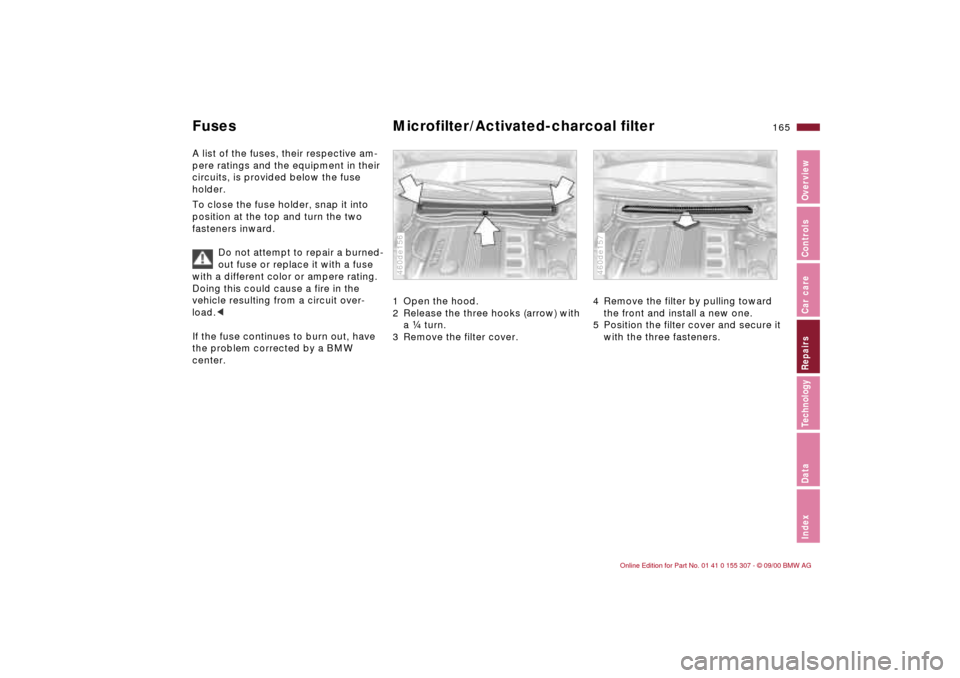
165n
IndexDataTechnologyRepairsCar careControlsOverview
Fuses Microfilter/Activated-charcoal filterA list of the fuses, their respective am-
pere ratings and the equipment in their
circuits, is provided below the fuse
holder.
To close the fuse holder, snap it into
position at the top and turn the two
fasteners inward.
Do not attempt to repair a burned-
out fuse or replace it with a fuse
with a different color or ampere rating.
Doing this could cause a fire in the
vehicle resulting from a circuit over-
load.<
If the fuse continues to burn out, have
the problem corrected by a BMW
center.
1 Open the hood.
2 Release the three hooks (arrow) with
a f turn.
3 Remove the filter cover.460de156
4 Remove the filter by pulling toward
the front and install a new one.
5 Position the filter cover and secure it
with the three fasteners.460de157
Page 173 of 203
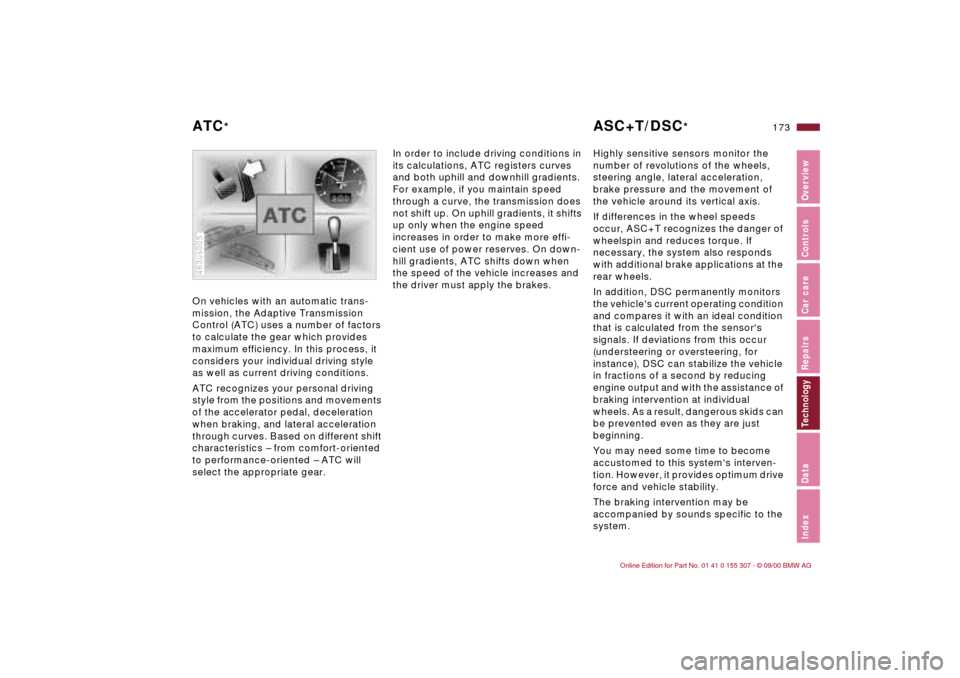
173n
IndexDataTechnologyRepairsCar careControlsOverview
On vehicles with an automatic trans-
mission, the Adaptive Transmission
Control (ATC) uses a number of factors
to calculate the gear which provides
maximum efficiency. In this process, it
considers your individual driving style
as well as current driving conditions.
ATC recognizes your personal driving
style from the positions and movements
of the accelerator pedal, deceleration
when braking, and lateral acceleration
through curves. Based on different shift
characteristics Ð from comfort-oriented
to performance-oriented Ð ATC will
select the appropriate gear.463us005
In order to include driving conditions in
its calculations, ATC registers curves
and both uphill and downhill gradients.
For example, if you maintain speed
through a curve, the transmission does
not shift up. On uphill gradients, it shifts
up only when the engine speed
increases in order to make more effi-
cient use of power reserves. On down-
hill gradients, ATC shifts down when
the speed of the vehicle increases and
the driver must apply the brakes.Highly sensitive sensors monitor the
number of revolutions of the wheels,
steering angle, lateral acceleration,
brake pressure and the movement of
the vehicle around its vertical axis.
If differences in the wheel speeds
occur, ASC+T recognizes the danger of
wheelspin and reduces torque. If
necessary, the system also responds
with additional brake applications at the
rear wheels.
In addition, DSC permanently monitors
the vehicle's current operating condition
and compares it with an ideal condition
that is calculated from the sensor's
signals. If deviations from this occur
(understeering or oversteering, for
instance), DSC can stabilize the vehicle
in fractions of a second by reducing
engine output and with the assistance of
braking intervention at individual
wheels. As a result, dangerous skids can
be prevented even as they are just
beginning.
You may need some time to become
accustomed to this system's interven-
tion. However, it provides optimum drive
force and vehicle stability.
The braking intervention may be
accompanied by sounds specific to the
system.
ATC
*
ASC+T/DSC
*
Page 175 of 203

175n
IndexDataTechnologyRepairsCar careControlsOverview
Four-wheel drive Safety belt tensionerThe transmission of power to the four
drive wheels is provided permanently
through a transfer box. The distribution
of torque between the front and rear
axles is 38% to 62%.
Traditional differential locks at the front
and rear axles and in the transfer box
are not required. Their function is
assumed by automatic braking inter-
vention at all four wheels. These trac-
tion interventions are governed by
Automatic Differential Brake (ADB-X), a
sub-function of DSC.
If a wheel tends to slip, it is braked
automatically by ADB-X until it once
again gains traction, and drive force
can be transmitted to that wheel. In
addition, the drive force is distributed to
the remaining wheels during this 530us133
system intervention. Engine output is
also reduced if necessary.
When the DSC is deactivated, the
ADB-X traction intervention is set for
the maximum drive force. However, the
engine intervention and the stability
controls are no longer available. For
this reason, DSC should only be deacti-
vated in the exceptional circumstances
described on page 81.
The BMW 325xi is not an off-road
vehicle. Instead, permanent four-wheel
drive provides a high degree of vehicle
stability and tractive ability under all
road conditions, and will aid you in crit-
ical driving situations, e. g. driving in
extreme winter conditions or on loose
road surfaces.The safety belt tensioner responds to
severe frontal collisions by tightening
the belts to ensure that occupants
remain firmly positioned in their seats.
A gas-pressure system retracts the
buckle assembly to tension the
shoulder and lap belts within fractions
of a second. This reduces the tendency
to slide under the lap belt.
390de330